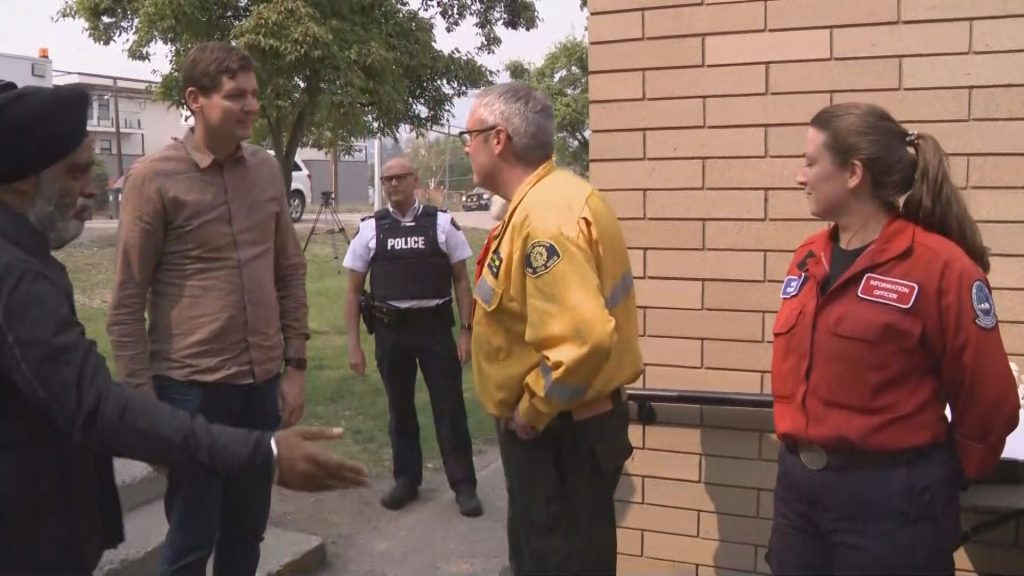West Kelowna wildfire fight moving into ‘recovery phase’: fire chief

Posted August 23, 2023 11:12 am.
Last Updated August 23, 2023 4:05 pm.
The fire chief of West Kelowna says the firefighting effort is moving into the “recovery phase,” as favourable weather has seen major progress on the massive McDougall Creek wildfire.
In an update Wednesday, Fire Chief Jason Brolund says there’s still lots of work to be done before residents can get back into their homes. However, he says priorities have shifted to getting people back.
“I can now confirm that within the city of West Kelowna and Westbank First Nation, there is 84 properties that have some level of damage,” Brolund said. “To clarify, this is properties with damage, not structures. This number may change as we continue to get farther and farther on the ground and our assessments get more and more in-depth.”
Brolund says the area saw rain overnight, and with an increase in humidity and cooler temperatures, it’s “going to be a boost for our response to this fire.” The McDougall Creek wildfire is now estimated to be 12,270 hectares.
“I just returned from flying over the fire … things are looking good, but I want to temper that with the fact that there is still a lot of work to be done.”
Brolund says crews are doing their best to get residents home, and additional evacuation orders are expected to be rescinded Wednesday.
Related Articles:
-
Kelowna’s tourism being hit hard by devastating wildfires
-
Wildfire smoke can damage the brain long after flames are extinguished, research says
-
West Kelowna residents look ahead to recovery as realtors expect post-wildfire boom
“But … they will come in small pieces. They will be nowhere near as large as when we asked you to leave,” he explained. “We’re looking at, first and foremost, is it safe to do so. So for me and my partners at the RCMP and the wildfire service, we’re considering things like, is the fire out in the neighborhood? We’re looking at debris and hazards that may be on the roads and in the properties.”
But Brolund shares it’s not just roads that crews are assessing — the list is long.
“We’re holding people back because we’re still firefighting in the neighborhood. There’s hoses and pumps. I can’t have you operating around that. I also can’t put you back if there’s still fires burning just in your backyard or nearby.
“These are the bigger factors that are keeping people out. But those are the bigger pieces of work that are being done in the neighborhoods. I think we’ve shown yesterday and today that we are able to move neighborhoods home as it’s safe to do so. We’re going to continue to do that wherever possible, but there are many factors that go into you returning to your home and I appreciate all the patience you’ve shown,” Brolund said.
He says the city is also looking at utilities and water levels, to determine “that we have enough water to fight fires in that neighbourhood, to make sure that your sewer is working, your power is secured, or that your natural gas is secured or on.”
“We’re analyzing the risk that’s out there: Is there a chance that it gets worse in your neighborhood? We want to avoid having to evacuate you a second time if this incident escalates, because it’s been proven that people are likely not to evacuate in some cases, if they have to evacuate again.”
Wildfire property damage to be outlined on website
The Central Okanagan Regional District Emergency Operation Centre says on Wednesday afternoon, it will have a centralized website up and running where residents in the region are able to look up their address, and be shown whether their property has been damaged or spared by wildfire.
Doug Gilchrist, Emergency Operations Centre director, says homeowners in affected areas can find property status on the CORD website.
“When you get to the website, you’ll be asked to put in your address and you will immediately get a response whether your property is fine or whether it has been damaged — partial or total structural loss,” Gilchrist explained.
“If your property is not listed as having significant damage, that does not mean you can go home — all the alerts and orders are still in place for those areas.”
Gilchrist says that when it has been deemed safe by fire crews, the owners of properties that have had significant losses will be taken to their properties on a “priority basis.”
“I know it’s going to be difficult information for people to receive — they are your homes and critically important pieces of your family and assets. And it’ll be a challenging, difficult conversation.”








